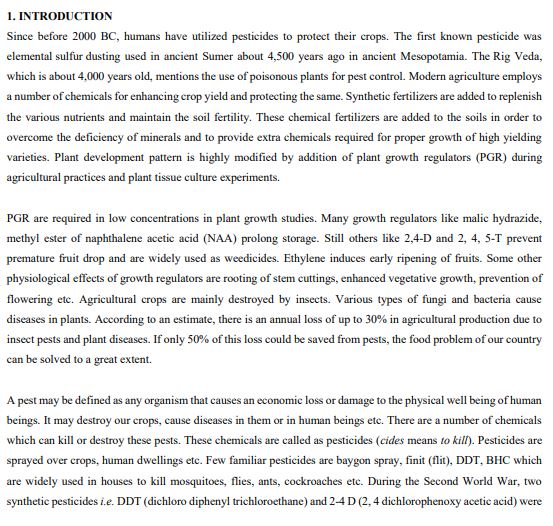‘List Of Insecticide’ PDF Quick download link is given at the bottom of this article. You can see the PDF demo, size of the PDF, page numbers, and direct download Free PDF of ‘INTEGRATED PEST MANAGEMENT FOR VEGETABLE CROPS’ using the download button.
Pesticides And Their Applications In Agriculture PDF Free Download

INTRODUCTION
Since before 2000 BC, humans have utilized pesticides to protect their crops.
The first known pesticide was elemental sulfur dusting used in ancient Sumer about 4,500 years ago in ancient Mesopotamia.
The Rig Veda, which is about 4,000 years old, mentions the use of poisonous plants for pest control.
Modern agriculture employs a number of chemicals for enhancing crop yield and protecting the same.
Synthetic fertilizers are added to replenish the various nutrients and maintain soil fertility.
These chemical fertilizers are added to the soils to overcome the deficiency of minerals and provide extra chemicals required for the proper growth of high-yielding varieties.
Plant development pattern is highly modified by the addition of plant growth regulators (PGR) during agricultural practices and plant tissue culture experiments.
PGR is required in low concentrations in plant growth studies.
Many growth regulators like malic hydrazide and methyl ester of naphthalene acetic acid (NAA) prolong storage.
Still others like 2,4-D and 2, 4, 5-T prevent premature fruit drop and are widely used as weedicides.
Ethylene induces the early ripening of fruits. Some other physiological effects of growth regulators are rooting of stem cuttings, enhanced vegetative growth, prevention of flowering etc.
Agricultural crops are mainly destroyed by insects.
Various types of fungi and bacteria cause diseases in plants.
According to an estimate, there is an annual loss of up to 30% in agricultural production due to insect pests and plant diseases.
If only 50% of this loss could be saved from pests, the food problem of our country could be solved to a great extent.
A pest may be defined as any organism that causes an economic loss or damage to the physical well-being of human beings.
It may destroy our crops, cause diseases in them or in human beings etc.
There are a number of chemicals which can kill or destroy these pests.
These chemicals are called pesticides (sides means to kill).
Pesticides are sprayed over crops, human dwellings etc. A few familiar pesticides are bygone spray, finite (flit), DDT, and BHC which are widely used in houses to kill mosquitoes, flies, ants, cockroaches etc.
During the Second World War, two synthetic pesticides i.e. DDT (dichloro diphenyl trichloroethane) and 2-4 D (2, 4 dichloro phenoxy acetic acid) were.
TYPES OF PESTICIDES
The Green Revolution succeeded in tripling the food supply but yet it was not enough to feed the growing human
population.
Increased yields have partly been due to the use of improved crop varieties, but mainly due to the use of
better management practices and the use of agrochemicals such as fertilisers and pesticides.
Pesticides are of several types depending upon the types of pests killed or controlled.
These are fungicides, weedicides/herbicides, nematicides, rodenticides, insecticides, and biopesticides.
Fungicides
These are substances used to eliminate fungal infection on crops and destroy fungal pathogens.
Inorganic fungicides include Bordeaux mixture, Burgandy Mixtue, sulphur, mercuric chloride, etc. Organic fungicides are distance S-21, distance M-22, than Z-78 (all carbamates), xanthines (e.g., vitavax), mercury compounds (e.g., agrosan, tiles), benzimidazole derivatives (e.g., benzilate).
Thiram and Ziram is fungicide but toxic to aquatic zooplankton.
Phytochemical extraction such as Neem oil containing Azadirachtin and Nimbin antifungal properties.
Fentin is another example of a fungicide.
Weedicides/Herbicides
Herbicides and weedicides are used to kill unwanted plants or weeds on agricultural land.
Depending upon the mode of action, there are selective and nonselective herbicides, contact herbicides, translocated herbicides, foliage applied and soil-applied herbicides.
Herbicides can be triazines (e.g., atrazine, simazine) carbamates (e.g., thiocarbamates, phenyl carbamates) and auxin derivatives (e.g., 2,4-D, and 2, 4, 5-T).
The mixture of 2,4-D, and 2, 4, 5-T is known as Agent orange used as a defoliant and herbicide developed during world war ii.
Modern herbicides may develop Parkinson’s disorder in humans such as paraquat.
Atrazine, a herbicide act as a teratogen and influences the gender development in frogs during metamorphosis.
| Author | – |
| Language | English |
| No. of Pages | 8 |
| PDF Size | 2 MB |
| Category | List |
| Source/Credits | researchgate.net |
Pesticides And Their Applications In Agriculture PDF Free Download
